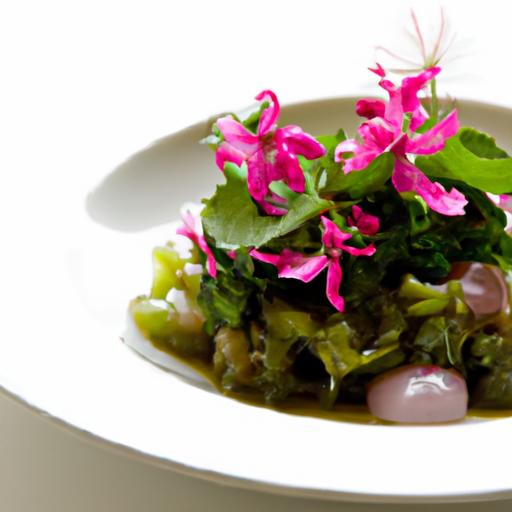In the vibrant world of cooking, the journey from raw ingredients to a symphony of flavors often hinges on a simple choice: when and how to add spices. Enter the captivating duel of blooming spices versus dry adding-a subtle art that can transform a dish from ordinary to extraordinary. Blooming spices, lovingly toasted or sizzling in hot oil, release an aromatic burst that awakens the senses, while dry adding spices preserves their pure, pungent power in tantalizing ways. Unlocking this flavor magic is like discovering a secret language spoken through scent and taste, inviting both novice cooks and seasoned chefs to elevate their culinary creations with intention and flair. Join us as we dive into the science and soul behind these two methods, revealing how timing and technique can unlock the fullest potential of spices in every bite.
Blooming Spices vs. Dry Adding: Unlocking Flavor Magic
Unlocking the full potential of spices is an art that transforms everyday cooking into a sensory experience. Blooming spices versus dry adding each bring unique aromas and depths, making them indispensable tools for every kitchen creator. Through containing and releasing essential oils, these techniques shape the flavor profile, turning simple ingredients into unforgettable dishes. This guide explores the science and technique behind each method to help you master flavor harmony effortlessly.
Prep and Cook Time
- Preparation: 15 minutes
- Cooking: 20 minutes
- Total Time: 35 minutes
Yield
Serves 4 generously
Difficulty Level
Medium – Ideal for enthusiasts ready to deepen their spice mastery
Ingredients
- 2 tbsp whole cumin seeds
- 1 tbsp coriander seeds
- 1 tsp fennel seeds
- 1 tsp mustard seeds
- 1/2 tsp turmeric powder
- 1 tsp chili flakes
- 1 large onion, finely chopped
- 4 garlic cloves, minced
- 2 tbsp oil (neutral or mustard oil)
- 1 can (400g) diced tomatoes
- Salt to taste
Instructions
- Heat the oil in a heavy-bottomed skillet over medium heat until shimmering but not smoking.
- Add whole spices (cumin, coriander, fennel, mustard seeds) carefully to the hot oil. Sauté until they start popping and releasing aromas, about 1-2 minutes. This process is key for blooming spices, coaxing their oils to bloom and intensify flavor.
- Remove pan from heat briefly and add the turmeric powder and chili flakes. Stir quickly to avoid burning; this dry adding stage conserves spice potency and texture in the final dish.
- Return the pan to medium heat and add chopped onions. Sauté until golden brown, about 7 minutes, stirring frequently to develop a rich base.
- Add minced garlic and cook for another 2 minutes until fragrant.
- Pour in diced tomatoes and simmer for 10 minutes, allowing all spices to meld harmoniously.
- Season generously with salt to balance and enhance all notes, then simmer for an additional 3-5 minutes until the sauce thickens slightly.
- Remove from heat and serve hot, savoring the depth created by the blooming and dry adding techniques.
Tips for Success
- Experiment with spice blends: Try adding cardamom pods or star anise during blooming for an exotic twist.
- Oil choice matters: Use oils with a high smoke point to avoid burnt notes that can blunt the spice aroma.
- Temperature control: Bloom spices at medium heat to gently coax oils without scorching, which causes bitterness.
- Dry adding spark: Incorporate dry spices off-heat first to protect their delicate oils, especially powder forms like turmeric and chili.
- Make ahead: The spiced sauce can be refrigerated for up to 3 days; reheat gently to preserve vibrancy.
Serving Suggestions
This richly spiced blend pairs beautifully as a flavorful topping over warmed basmati rice or folded into creamy yogurt for contrast. Garnish with freshly chopped cilantro and a wedge of lime to add brightness and lift the intense aromas. For an elevated experience, serve alongside warm, soft naan bread allowing guests to scoop up every drop of fragrant delight.

| Nutrient | Per Serving |
|---|---|
| Calories | 180 kcal |
| Protein | 4g |
| Carbohydrates | 12g |
| Fat | 12g |
For more spice mastery, check out our detailed guide on essential spice blends to master. For scientific insights on spice chemistry, visit ScienceDaily’s article on spices and flavor.
Q&A
Q&A: Blooming Spices vs. Dry Adding – Unlocking Flavor Magic
Q1: What does “blooming spices” actually mean?
A1: Blooming spices is the culinary technique of gently heating whole or ground spices in oil or butter before adding other ingredients. This warms up the spices, releasing their natural oils and awakening hidden flavors, much like coaxing a flower to bloom.
Q2: How is blooming different from just adding dry spices directly to a dish?
A2: When you add dry spices straight into a dish, especially late in cooking, they often stay muted or develop a raw, sometimes bitter taste. Blooming, on the other hand, activates the spices, allowing their aromas and flavors to fully expand and deepen, creating a richer, more complex profile.
Q3: What kinds of dishes benefit the most from blooming spices?
A3: Curries, stews, soups, and stir-fries are perfect playgrounds for blooming. Dishes that thrive on layered, intense flavors-think Indian, Middle Eastern, and North African cuisine-get an extra punch of complexity and warmth when spices are bloomed first.
Q4: Can all spices be bloomed?
A4: Most whole spices like cumin seeds, cardamom pods, coriander seeds, and mustard seeds are ideal for blooming. Ground spices can also be bloomed, but it’s best to do so carefully over low heat to avoid burning. Delicate spices like saffron or dried herbs might lose their nuance if exposed to too much heat upfront.
Q5: What are some tips for successful spice blooming?
A5: Use a neutral oil or butter, moderate heat, and keep stirring to avoid burning. Add spices to warm oil gradually; when you hear popping or see a fragrant scent rise, they’re blooming beautifully. Timing is key-don’t overcook them, or the magic fades.
Q6: How does blooming spices compare nutritionally or health-wise?
A6: Blooming spices can actually enhance the absorption of some beneficial compounds like curcumin in turmeric. Heat releases essential oils packed with antioxidants and anti-inflammatory agents, making your dish not just tastier but potentially healthier.
Q7: Is it possible to bloom spices without oil?
A7: You can dry-toast whole spices in a hot pan without oil to awaken their aroma, but blooming typically implies the involvement of fat to extract and carry flavors more effectively. Dry toasting is aromatic but less about flavor infusion.
Q8: Can blooming be done ahead of time?
A8: Yes! You can bloom spices in oil and store the infused oil in the fridge for a few days. That oil becomes a flavor-packed base for quick cooking later-just bring it back to room temp before using.
Q9: What magic happens when you skip blooming and add dry spices late?
A9: Without blooming, spices may taste flat, sharp, or even bitter, lacking the roundness and depth that develops with heat and fat. You miss out on the full symphony of aromatic notes that bloom unlocks.
Q10: In short, why should every home cook learn the art of blooming spices?
A10: Because it transforms simple ingredients into extraordinary dishes. Blooming spices is like unlocking a secret door to flavor-a small step that creates big, unforgettable taste explosions. It’s flavor magic waiting to be unleashed in every kitchen!
Final Thoughts
As we’ve uncovered, the choice between blooming spices and dry adding isn’t just a culinary detail-it’s a gateway to unlocking layers of flavor that transform everyday dishes into memorable experiences. Blooming spices invite their essential oils to dance in hot fat, releasing aromas that sing and spice that lingers, while dry adding offers a more subtle whisper of their essence. By understanding when and how to wield each technique, you hold the key to mastering the flavor magic that spices promise. So next time you reach for that jar of cumin or cardamom, remember: it’s not just what you add, but how you add it that makes all the difference. Happy cooking, and may your kitchen always be fragrant with possibility!


